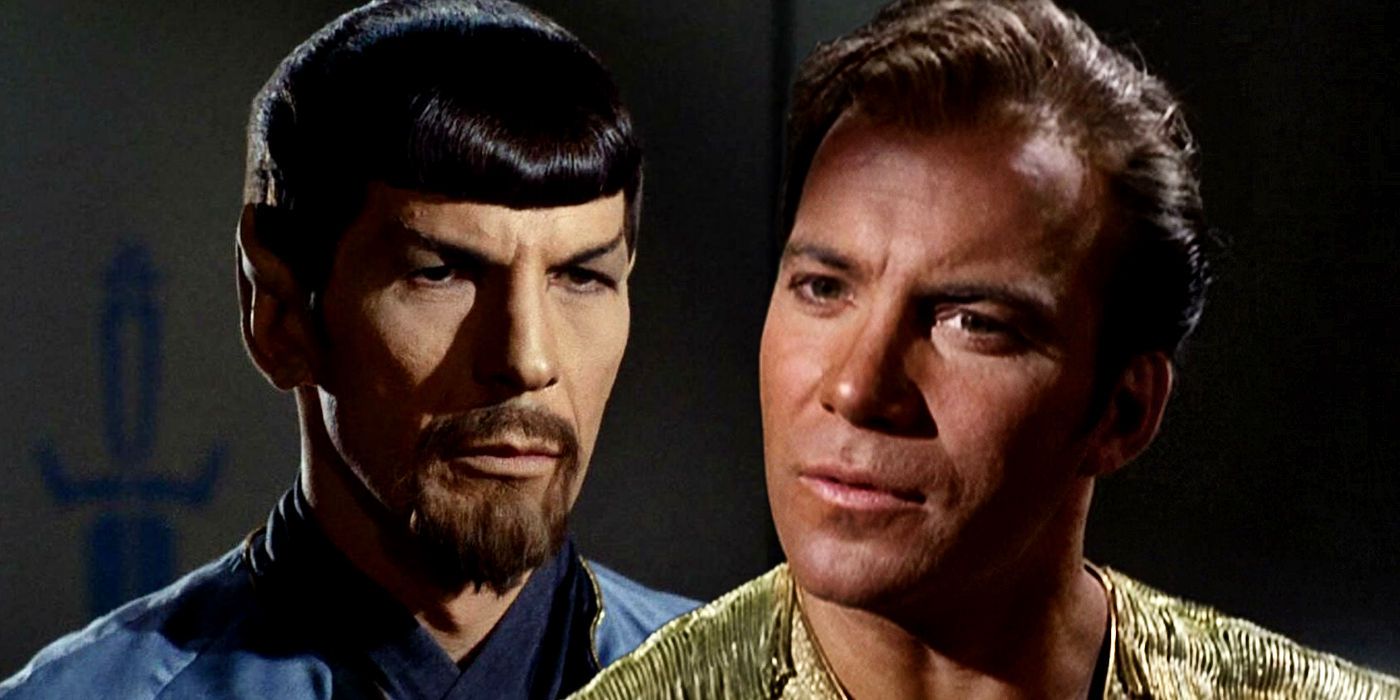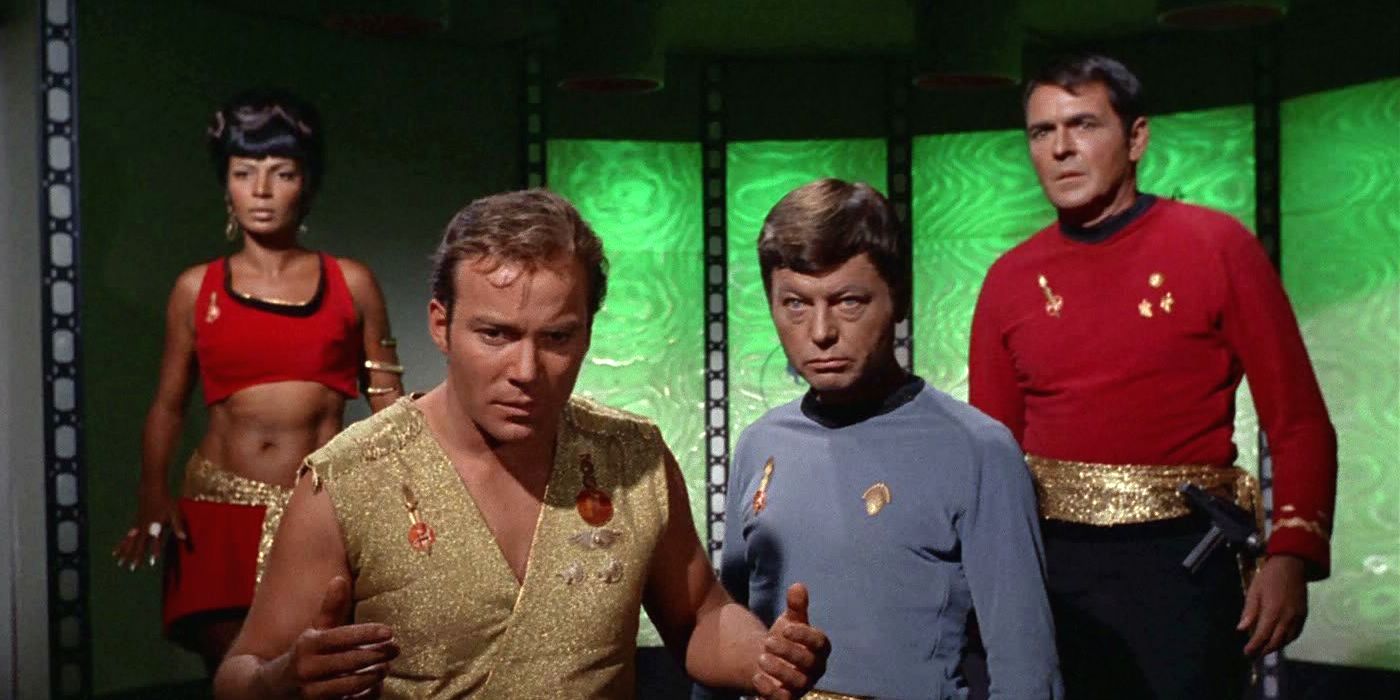The Mirror Universe is one of Star Trek's most intriguing and enduring concepts largely thanks to Gene Roddenberry's changes to the alternate reality in Star Trek: The Original Series. The Mirror Universe debuted in TOS's season 2 episode "Mirror Mirror", but the new book Star Trek: A Celebration, by Ben Robinson and Ian Spelling, explains how themes that Roddenberry and TOS' producing team drastically improved the original vision that exact duplicates of Captain Kirk (William Shatner) and the USS Enterprise exist.
In Star Trek's original Mirror Universe episode, a transporter accident switched Kirk, Dr. Leonard McCoy (DeForrest Kelley), Scotty (James Doohan), and Lt. Uhura (Nichelle Nichols) with their Mirror Universe counterparts. Kirk and his friends encountered a goateed Mr. Spock (Leonard Nimoy) and learned that this universe was ruled by the totalitarian Terran Empire instead of the United Federation of Planets. Before Kirk returned to his proper universe, he planted convinced Mirror Spock to overthrow the Terran Empire, which was en route to its own destruction. The Mirror Universe was explored further in Star Trek: Deep Space Nine, which depicted the broken Terrans conquered by the Klingon/Cardassian Alliance a century after Kirk met Mirror Spock. A fan-favorite Mirror Universe two-parter was featured in Star Trek: Enterprise season 4. Finally, Star Trek: Discovery delivered the most thorough examination of the Mirror Universe yet and introduced the pivotal character of Emperor Philippa Georgiou (Michelle Yeoh).
While the idea for Star Trek's Mirror Universe came from sci-fi author Jerome Bixby, who wrote a short story called "One Way Street" about a parallel universe and a character with a goatee, Gene Roddenberry's rules-establishing 1964 document Star Trek Is... also had an idea called "The Mirror" where the USS Yorktown (before it was changed to the USS Enterprise) encountered a duplicate ship with a crew of exact doppelgangers. Star Trek producers Gene Coon and D.C. Fontana joined Roddenberry in combining the concepts and they made changes that led to the Mirror Universe's Terran Empire becoming the dark opposite of the Federation. The key to the Mirror Universe is the intrigue of Star Trek's familiar characters living in a fascist society and examining how different they are from the Enterprise crew fans knew and loved.
In the original draft of "Mirror Mirror," Kirk was the only Star Trek character who crossed over to the alternate reality. Kirk learned that the Mirror Universe Starfleet is at war with an alien race called the Tharn but the humans hadn't developed the phaser yet. Kirk then helps create the phaser which led to Starfleet winning the war. That story was changed to make the Terran Empire itself the villains of the Mirror Universe, which was a more interesting idea that created the contrast between the idyllic Federation and the fascistic Mirror Universe that Star Trek continues to explore.
Roddenberry also suggested that the rest of the cast be utilized in "Mirror Mirror." As the producer, he knew it was more cost-effective to use Star Trek's regular company of actors than bringing in a slew of guest stars to work with Captain Kirk. But from a creative standpoint, it was also an ingenious move. Much of the fun of the Mirror Universe is to see Spock and others' evil doppelgangers. "Mirror Mirror" showcased twisted versions of Mr. Sulu (George Takei) and Chekov (Walter Koenig) while in the Prime reality, Spock had to lock up the evil Mirrors of Kirk, Bones, Scotty, and Uhura in the brig.
Star Trek's Mirror Universe stories are enduringly popular thanks to Gene Roddenberry's decision to involve the entire cast. Seeing the alternate versions of heroes like DS9's Major Kira Nerys (Nana Visitor), who became the seductress called the Intendant, Enterprise's Ensign Hoshi Sato (Linda Park), who schemed her way to becoming the Terran Empress, and Star Trek: Discovery's Michael Burnham (Sonequa Martin-Green), whose Mirror counterpart is savage and ruthless, is why the Mirror Universe episodes are so entertaining. Every time fans get a glimpse into Star Trek's Mirror Universe, it's because Gene Roddenberry and his producing team had the necessary vision of how the broken mirror would best reflect back upon Star Trek's beloved characters.


